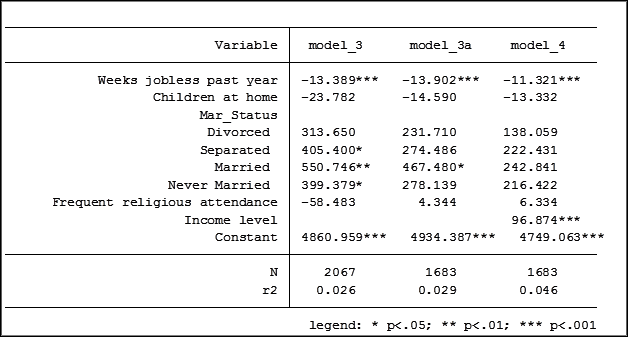

This user-written command is nice because it creates a variable that captures all the information needed to. The second example will use a user-written program. The first example will use commands available in base Stata. There are two methods available for this task.
#Drop if stata how to#
© W. This Stata FAQ shows how to check if a dataset has duplicate observations. In other words, any data transformations effected within the preserve - restore clause will be lost once you have restored the original data. A very brief example could go like this:īut note that (in contrast to SPSS's filter command) any changes made to the data after preserve will be "undone" by restore.
#Drop if stata full#
This allows you to drop cases, do your analyses and finally return to the full data set. Once you have eliminated observations, you cannot read them back in again. Warning: drop and keep are not reversible. keep works the same way as drop, except that you specify the variables or observations to be kept rather than the variables or observations to be deleted.
#Drop if stata code#
if datey) Hope that's helpful Edit: Or yes, and RoguePenguin suggests, fix the original code so you never have the problem. I tried the following: generate rightwing 0 replace rightwing 1 if politicalp'party1' & politicalp'party2' also tried. I have a list of political parties and I wanted to create a dummy variable for right-wing parties. However, you can do analyses for a subset of your data using the if clause.Īnother way for achieving this is using the preserve - restore clause. drop eliminates variables or observations from the data in memory. Still not entirely sure I follow, but the two obvious routes to me are: Drop the entire observation on that date ( drop if date x) Replace the variable as missing on that day (replace X. Newbie to Stata, looking for a way to create a dummy variable that captures two if commands. Ss (in analogy to the filter by command in SPSS). Note that there seems to be no simple way to temporarily exclude cases from analyse Using "keep" instead of drop would keep all cases with no income. Will delete all cases whose income equals zero.
One could have more complication expressions like 'drop if VARNAME1<5 & VARNAME2>5' and so forth.For example, 'drop if VARNAME<4' will drop all observations that have VARNAME<4. Note that, in contrast to SPSS, you cannot drop or keep variables while saving a data set. Another way to drop delete observations is to use an if' clause. Using "keep" instead of drop would delete all variables not listed. Will delete the variables listed after "drop" from your data set. The same commands are used for dropping / keeping variables or cases. In this case you can also tell Stata to keep list of variables This will cause Stata to only retain the specified variables. Multiple Imputation: Analysis and Pooling Steps To drop entire variables, simply type drop variable name If you have a giant data set and only want to keep one or two variables, it is a lot faster to do the opposite command.As we saw in the Pie chart guide, we need to customize the starting and ending values of each slice.Since the. Make sure you have saved your original dataset. Let’s just keep the last hats as x and y.

Confidence Intervals with ci and centile To drop observations, you need to combine one of two Stata commands (keep or drop) with the if qualifier.Changing the Look of Lines, Symbols etc.


 0 kommentar(er)
0 kommentar(er)
